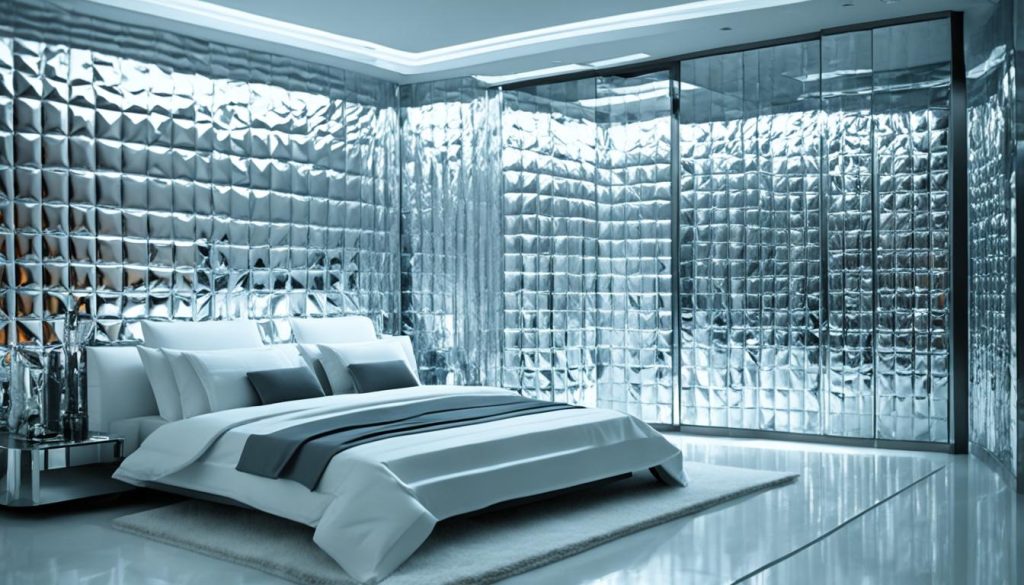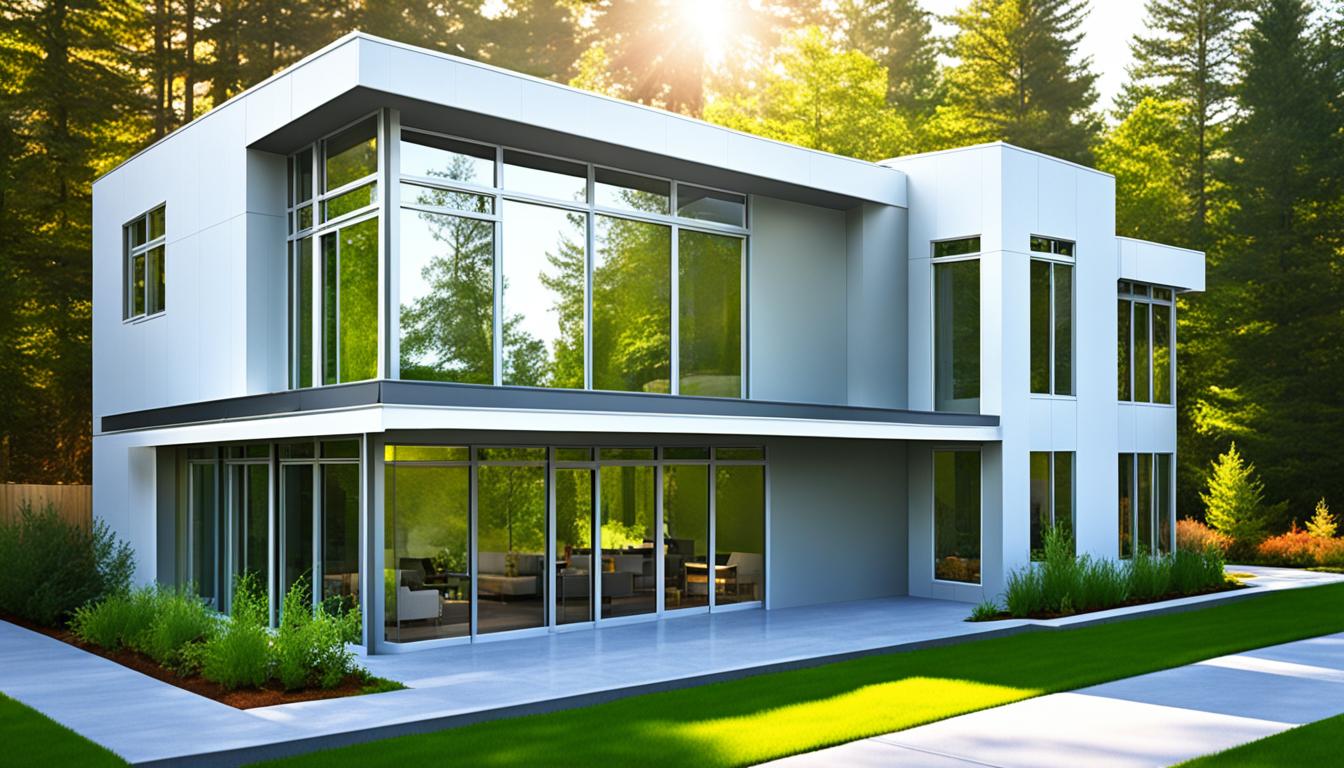Did you know that radiant heat accounts for up to 50% of the heat gain in a typical home? That’s right! A significant amount of heat from the sun enters your living space through the roof, making your cooling system work harder and driving up energy bills.
Luckily, there’s a solution that can make your home more energy-efficient and reduce your cooling costs: radiant barrier walls. These cutting-edge walls are designed to combat radiant heat gain, keeping your home cooler in the summer and warmer in the winter.
Key Takeaways:
- Radiant heat accounts for up to 50% of heat gain in homes.
- Radiant barrier walls can enhance home energy efficiency.
- Radiant barrier walls keep homes cooler in summer and warmer in winter.
- Reducing radiant heat gain can lower cooling costs.
- Installing radiant barrier walls is a smart investment for long-term energy savings.
How Radiant Barriers Work
Radiant barriers function by reflecting radiant heat away from the surface they are installed on. They are made from highly reflective materials, such as aluminum, that prevent the absorption and re-radiation of heat.
When the sun heats up the roof during the summer, the radiant heat would typically transfer into the attic and warm up the house. However, with a radiant barrier in place, the heat is reflected back towards the roof, keeping the attic and the living space cooler.
This type of insulation primarily addresses radiant heat transfer and is most effective in the summer months when heat accumulation is a concern. Radiant barriers can be installed between rafters or on attic walls to enhance the performance of existing insulation. In addition to reducing energy costs, radiant barriers also help keep homes warmer in the winter by minimizing heat loss through the roof.
Radiant Barriers vs. Traditional Insulation
When it comes to enhancing energy efficiency, traditional insulation materials like fiberglass batts have long been the go-to solution. These materials primarily focus on slowing down conductive heat transfer by trapping air to resist the flow of heat. However, radiant barriers offer a different approach that complements traditional insulation methods.
Radiant barriers are designed to reflect radiant heat away from the surface they are installed on, making them an effective tool for maintaining a comfortable living environment. Rather than attempting to slow down heat transfer, radiant barriers work by preventing the absorption and re-radiation of heat. By implementing radiant barriers alongside traditional insulation, homeowners can create comprehensive thermal protection for their homes.
One of the key advantages of radiant barriers is their eco-friendly nature. Made from sustainable building materials, such as aluminum foil, radiant barriers help minimize the carbon footprint of homes by reducing energy usage and waste. By reflecting radiant heat away, radiant barriers contribute to a more energy-efficient home, ultimately benefitting both the environment and homeowners’ wallets.

Types of Radiant Barrier Materials
When it comes to reflective insulation walls, there are various radiant barrier materials to choose from. Understanding the different options can help you make an informed decision for your home. Let’s explore the types of radiant barrier materials available:
1. Reflective Metal Roofing
If you want a clean exterior look without visible foil, reflective metal roofing is a great option. This type of roofing incorporates a radiant barrier into the roofing material itself. The reflective surface helps to deflect radiant heat and enhances energy efficiency.
2. Radiant Roof Sheathing
Radiant roof sheathing is another effective choice for boosting home energy efficiency. It involves a reflective foil facing that is adhered to one side of the structural roof deck material. This combination of radiant barrier and roof decking is commonly used during new construction and provides seamless integration.
3. Metal Foil (such as Aluminum Foil)
Metal foil, particularly aluminum foil, is one of the most common and cost-effective radiant barrier materials available. It is widely accessible, as it can be purchased in rolls from home improvement stores. This makes it suitable for DIY projects. Aluminum foil radiant barriers can be applied on top of rafters in new construction or on the underside of rafters in existing homes.
Proper installation is crucial to maximize the effectiveness of metal foil radiant barriers. The reflective side should face down towards the attic space, and seams should be overlapped and taped to prevent gaps that can compromise the barrier’s performance.
Comparison of Radiant Barrier Materials
| Radiant Barrier Material | Advantages | Considerations |
|---|---|---|
| Reflective Metal Roofing | – Provides a clean exterior look without visible foil – Reflects radiant heat away from the roof – Enhances energy efficiency |
– May require professional installation – Higher initial cost compared to other options |
| Radiant Roof Sheathing | – Integrates radiant barrier with roof decking – Suitable for new construction projects – Enhances energy efficiency |
– Limited applicability to existing homes – Requires proper installation during construction |
| Metal Foil (such as Aluminum Foil) | – Cost-effective solution – Suitable for DIY installation – Reflects radiant heat away from the attic |
– Requires proper installation to prevent gaps – Effectiveness may vary based on existing insulation |
Reflective insulation walls and radiant roof sheathing offer a more integrated approach, while metal foil radiant barriers provide versatility and accessibility for homeowners. Consider factors such as your home’s construction, budget, and specific requirements when selecting the most suitable radiant barrier material.

Considerations for Radiant Barrier Installation
Installing a radiant barrier in your home can be a cost-effective way to improve energy efficiency and reduce cooling costs, especially in hot southern climates. However, it’s important to carefully consider a few key factors before proceeding with the installation.
First and foremost, the climate of your location plays a significant role in determining the effectiveness of a radiant barrier. According to the Department of Energy, radiant barriers can save 5% to 10% on cooling costs in the southern half of the United States. In cooler regions, the impact may be less significant, and it may be more cost-effective to focus on other forms of insulation.
Additionally, attic ventilation is a crucial aspect to consider when installing a radiant barrier. Proper airflow in the attic allows for the escape of heat buildup, maximizing the performance of the barrier. Without adequate ventilation, the effectiveness of the radiant barrier may be compromised.
Given the importance of proper installation and optimal results, it is highly recommended to have a radiant barrier installed by trained professionals. Their expertise ensures the correct placement of the barrier and guarantees that you reap its full benefits. To make an informed decision, solicit quotes from multiple contractors to assess the costs and find the right fit for your needs.
